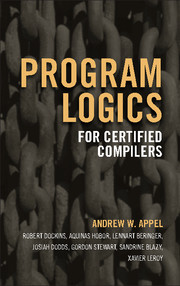Book contents
- Frontmatter
- Dedication
- Contents
- Road map
- Acknowledgments
- 1 Introduction
- I Generic separation logic
- II Higher order separation logic
- III Separation logic for CompCert
- IV Operational semantics of CompCert
- 31 CompCert
- 32 The CompCert memory model
- 33 How to specify a compiler
- 34 C light operational semantics
- V Higher-order semantic models
- VI Semantic model and soundness of Verifiable C
- VII Applications
- Bibliography
- Index
34 - C light operational semantics
from IV - Operational semantics of CompCert
Published online by Cambridge University Press: 05 August 2014
- Frontmatter
- Dedication
- Contents
- Road map
- Acknowledgments
- 1 Introduction
- I Generic separation logic
- II Higher order separation logic
- III Separation logic for CompCert
- IV Operational semantics of CompCert
- 31 CompCert
- 32 The CompCert memory model
- 33 How to specify a compiler
- 34 C light operational semantics
- V Higher-order semantic models
- VI Semantic model and soundness of Verifiable C
- VII Applications
- Bibliography
- Index
Summary
CompCert defines a formal small-step operational semantics for every intermediate language (including C light) between C and assembly language.
For Verifiable C, we use the C light syntax with an alternate (non-standard) operational semantics of C light (file veric/Clight_new.v). Our nonstandard semantics is quite similar to the standard, but it makes fewer “administrative small-steps” and is (in this and other ways) more conducive to our program-logic soundness proof. We prove a simulation relation from our alternate semantics to the CompCert standard C light semantics. This ensures that the soundness we prove relative to the alternate semantics is also valid with respect to the standard semantics.
In our operational semantics, an operational state is either internal, when the compiled program is about to execute an ordinary instruction of a single C thread; or external, when the program is requesting a system call or other externally visible event.
An internal operational state contains:
genv Global environment, mapping identifiers to addresses of global (extern) variables and functions, and a separate mapping of function-addresses to function-bodies.
ve Variable environment, mapping identifiers to addresses of addressable local variables—those to which the C-language & (address-of) operator is somewhere applied.
te Temp environment, mapping identifiers to values of ordinary local variables—those to which & is never applied.
k Continuation, representing the stack of control and data (including the program counter, return addresses for function calls, and local variables of suspended functions).
- Type
- Chapter
- Information
- Program Logics for Certified Compilers , pp. 288 - 293Publisher: Cambridge University PressPrint publication year: 2014



